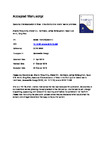Resource characterization of sites in the vicinity of an island near a landmass
| dc.contributor.author | Pérez-Ortiz, A | |
| dc.contributor.author | Borthwick, Alistair | |
| dc.contributor.author | McNaughton, J | |
| dc.contributor.author | Smith, HCM | |
| dc.contributor.author | Xiao, Q | |
| dc.date.accessioned | 2021-08-22T17:06:28Z | |
| dc.date.available | 2021-08-22T17:06:28Z | |
| dc.date.issued | 2017-04 | |
| dc.identifier.issn | 0960-1481 | |
| dc.identifier.issn | 1879-0682 | |
| dc.identifier.uri | http://hdl.handle.net/10026.1/17712 | |
| dc.description.abstract |
Renewable energy technologies are undergoing rapid development, the global aim being to achieve energy security and lower carbon emissions. Of marine renewable energy sources, tidal power has inherent predictability and large theoretical potential, estimated to exceed 8000 (TW h)a−1 in coastal basins. Coastal sites in the vicinity of an island near a landmass are prime candidates for tidal stream power exploitation by arrays of turbines. This paper characterizes numerically the upper limit to power extraction of turbines installed at such sites. It is demonstrated that the maximum power extracted from the strait is generally not well approximated by either the power dissipated naturally at the seabed or the undisturbed kinetic power of flow in the strait. An analytical channel model [C. Garrett and P. Cummins, “The power potential of tidal currents in channels,” Proc. R. Soc. A Math. Phys. Eng. Sci., vol. 461, no. 2060, pp. 2563–2572, Aug. 2005] provides lower predictions than the present numerical model of available power in the strait due to the analytical model not accounting for changes to the driving head resulting from power extraction and flow diversion offshore of the island. For geometrically long islands extending parallel to the landmass, the numerically predicted extracted power is satisfactorily approximated by the power naturally dissipated at the seabed, and there is reasonable agreement with the estimate by the channel analytical model. It is found that the results are sensitive to choice of boundary conditions used for the coastlines, the eddy viscosity, and bed friction. Increased offshore depth and lower blockage both reduce the maximum power extracted from the strait. The results indicate that power extracted from the site can be maximum if extraction is implemented both in the strait and offshore of the island. Presence of the landmass and increasing island dimensions both enhance power extraction. | |
| dc.format.extent | 265-276 | |
| dc.language | en | |
| dc.language.iso | en | |
| dc.publisher | Elsevier BV | |
| dc.subject | 7 Affordable and Clean Energy | |
| dc.subject | 13 Climate Action | |
| dc.title | Resource characterization of sites in the vicinity of an island near a landmass | |
| dc.type | journal-article | |
| dc.type | Journal Article | |
| plymouth.volume | 103 | |
| plymouth.publication-status | Published | |
| plymouth.journal | Renewable Energy | |
| dc.identifier.doi | 10.1016/j.renene.2016.10.086 | |
| plymouth.organisational-group | /Plymouth | |
| plymouth.organisational-group | /Plymouth/Faculty of Science and Engineering | |
| plymouth.organisational-group | /Plymouth/Faculty of Science and Engineering/School of Engineering, Computing and Mathematics | |
| plymouth.organisational-group | /Plymouth/Users by role | |
| plymouth.organisational-group | /Plymouth/Users by role/Academics | |
| dc.identifier.eissn | 1879-0682 | |
| dc.rights.embargoperiod | Not known | |
| rioxxterms.versionofrecord | 10.1016/j.renene.2016.10.086 | |
| rioxxterms.licenseref.uri | http://www.rioxx.net/licenses/all-rights-reserved | |
| rioxxterms.type | Journal Article/Review |


